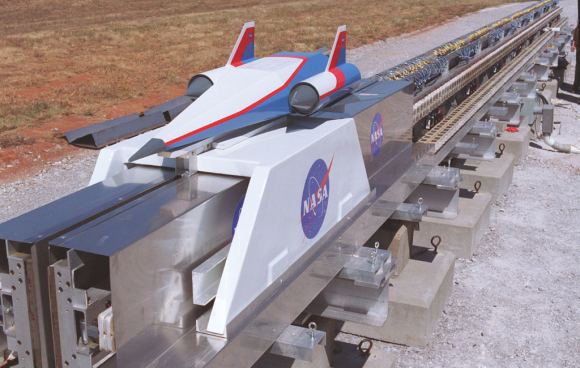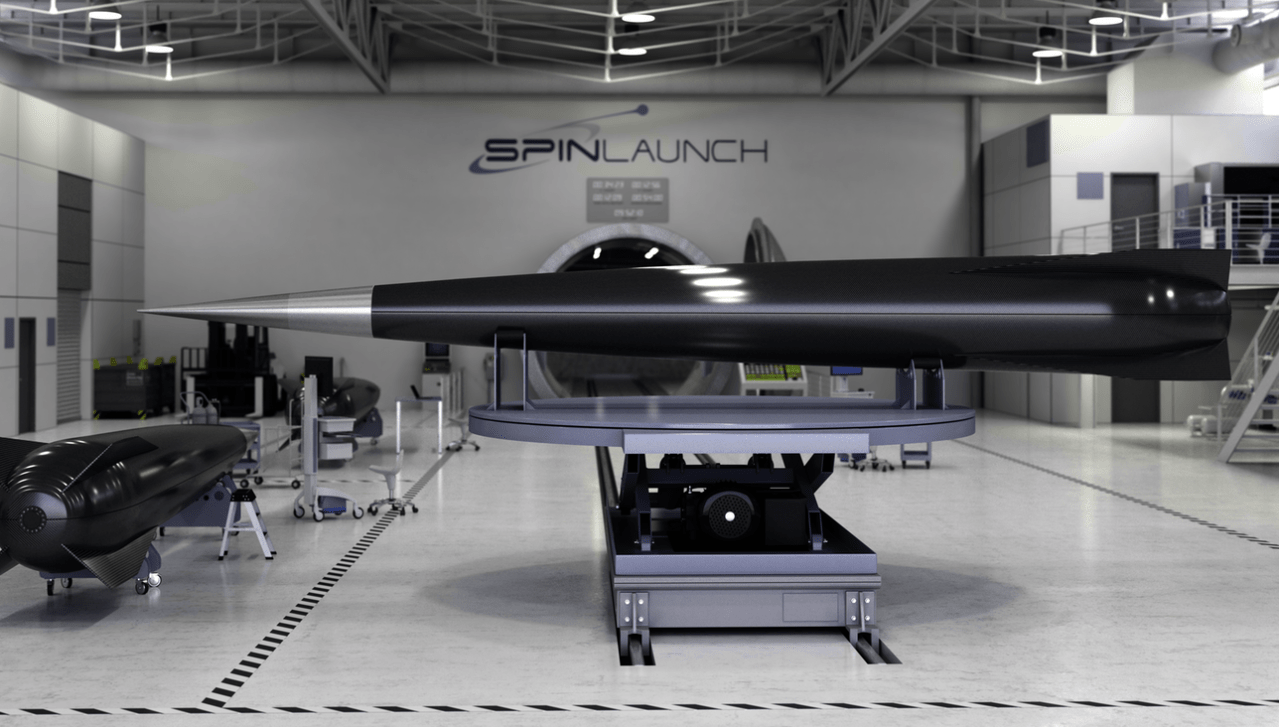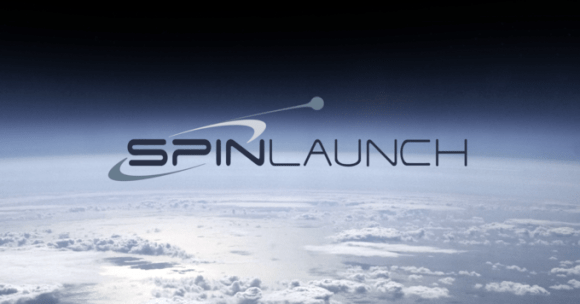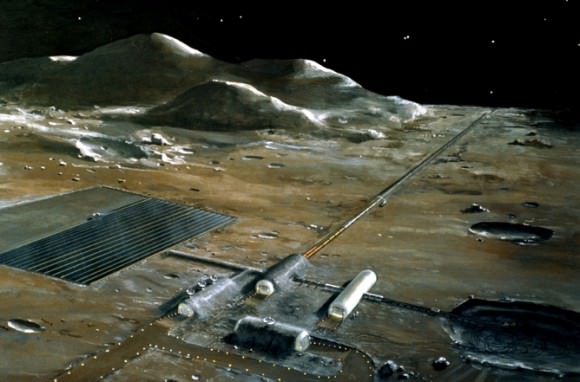Of all challenges presented by space exploration – and to be fair, there are many! – one of the greatest is the cost. When it comes right down to it, launching disposable rockets from Earth and getting them to the point where they can achieve escape velocity and reach space is expensive. In addition, these rockets need to be big, powerful and hold a lot of fuel to lift spacecraft or cargo.
For this reason, so many efforts in the past few decades have been focused on reducing the cost of individual launches. There are many ways to make launch vehicles cheaper, ranging from reusable rockets to reusable spacecraft (i.e., the Space Shuttle). But to Jonathan Yaney, the founder of SpinLaunch, a real cost-cutting solution is to propel smaller payloads into orbit using a space catapult instead.
The concept of a space catapult is simple and has been explored at length since the dawn of the Space Age. Also known as a mass driver or coilgun, the concept relies on a set of powerful electromagnetic rails to accelerate spacecraft or payloads to escape velocity and launch them horizontally. Since the 1960s, NASA has been exploring the concept as an alternative to conducting rocket launches.

In addition, NASA has continued developing this technology through the Marshall Space Flight Center and the Kennedy Space Center. Here, engineers have been working on ways to launch spacecraft horizontally using scramjets on an electrified track or gas-powered sled. A good example of this is the Magnetic Levitation (MagLev) System which uses the same technology as a maglev train to accelerate a small space plane into orbit.
Another variation on the concept involves a centrifuge, where the spacecraft or cargo is accelerated on a circular track until it reaches escape velocity (and then launches). This concept was proposed by Dr. Derek Tidman – a physicist who specialized in electrothermal and electromagnetic acceleration – in the 1990s. Known as the Slingatron, this version of the space catapult is currently being researched by HyperV Technologies.
However, these ideas were never adopted because vast improvements in electromagnetic induction technology were needed to achieve the speed necessary to put heavy payloads into space. But thanks to advancements in high-speed maglev trains, recent attempts to create Hyperloop pods and tracks, and the growth of the commercial aerospace market, the time may be ripe to revisit this concept.
Such is the hope of Jonathan Yaney, an aerospace enthusiast with a long history of co-founding startups. As he describes himself, Yaney is a “serial entrepreneur” who has spent the past 15 years founding companies in the fields of consulting, IT, construction, and aerospace. Now, he has established SpinLaunch for the sake of launching satellites into space.
And while Yaney has been known for being rather recluse, TechCrunch recently secured an exclusive interview and gained access to the company hangar. According to multiple sources they cite, Yaney and the company he founded are launching a crowdfunding campaign to raise the $30 million in Series A funding to develop the catapult technology. In the course of the interview, Yaney expressed his vision for space exploration as follows:
“Since the dawn of space exploration, rockets have been the only way to access space. Yet in 70 years, the technology has only made small incremental advances. To truly commercialize and industrialize space, we need 10x tech improvement.”
According to a source cited by TechCrunch, SpinLaunch’s design would involve a centrifuge that accelerates payloads to speeds of up to 4,828 km/h (3,000 mph). Additionally, the cargo could be equipped with supplemental rockets to escape Earth’s atmosphere. By replacing rocket boosters with a kinetic launch system, SpinLaunch’s concept would rely on principles similar to those explored by NASA.
But as he went on to explain, the method his company is exploring is different. “SpinLaunch employs a rotational acceleration method, harnessing angular momentum to gradually accelerate the vehicle to hypersonic speeds,” he said. “This approach employs a dramatically lower cost architecture with much lower power.” Utilizing this technology, Yaney estimates that the costs of individual launches could be reduced to $500,000 – essentially, by a factor of 10 to 200.
According to Bloomberg Financial, not much more is known about the company or its founder beyond a brief description. However, according to SEC documents cited by TechCrunch, Yaney managed to raise $1 million in equity in 2014 and $2.9 million in 2015. The same documents indicate that he was $2.2 million in debt by mid-2017 and another $2 million in debt by late 2017.
Luckily, the Hawaii state senate introduced a bill last month that proposed issuing $25 million in bonds to assist SpinLaunch with constructing its space catapult. Hawaii also hopes to gain construction contracts for the launch system as part of its commitment to making space accessible. As it states in the bill:
“[T]he department of budget and finance, with the approval of the governor, is authorized to issue special purpose revenue bonds in a total amount not to exceed $25,000,000, in one or more series, for the purpose of assisting SpinLaunch Inc., a Delaware corporation, in financing the costs relating to the planning, design, construction, equipping, acquisition of land, including easements or other interests therein, and other tangible assets for an electrically powered, kinetic launch system to transport small satellites into low Earth orbit.”
In the meantime, Yaney is looking to the public and several big venture capital firms to raise the revenue he needs to make his vision a reality. Of course, beyond the issue of financing, several technical barriers still need to be addressed before a space catapult could be realized. The most obvious of these is how to overcome the air resistance produced by Earth’s dense atmosphere.
However, Yaney was optimistic in his interview with TechCrunch, claiming that his company is investigating these and other challenges:
“During the last three years, the core technology has been developed, prototyped, tested and most of the tech risk retired. The remaining challenges are in the construction and associated areas that all very large hardware development and construction projects face.”
There’s no indication of when such a system might be complete, but that’s to be expected at this point. However, with the support of the Hawaiian government and some additional capital, his company is likely to secure its Series A funding and begin moving to the next phase of development. Much like the Hyperloop, this concept may prove to be one of those ideas that keep advancing because of the people who are willing to make it happen!
And be sure to check out this video about SpinLaunch’s crowdfunding campaign, courtesy of Scott Manley:
Further Reading: TechCrunch




Sorry. – 3,000mph at sea level or even 10,000ft – no way. Hyperloop might seem outlandish, but travel is in a low pressure environment. The SR-71 for 2,000mph was at upwards of 50,000ft. Roton was less fanciful than this. Just do some maths.
Finally, a site publishing this story that DOESN’T require Facebook to leave a comment.
Here’s my comment: SpinLaunch is a scam, plain and simple.
Jonathan Yaney is not an aerospace engineer. None of the people endorsing him for “aerospace” on LinkedIn are either. His best buddy, when it comes to endorsing his “skills” is a guy named Arthur Meyerovich, the CEO of some company called solidopinion.com, which makes the following claims:
“SolidOpinion is an engagement company. We track, power, drive, and reward engagement. All the tools you need. At the heart of our technology is a digital currency. Advertisers use this currency to get their message out. Users earn it through engagement. Publishers profit by creating places to spend it. Effective. Cutting edge.”
Bull$hit. Other “endorsers” include a Maximus Y., who “like[s] to build $hit.”, a Jose Carranza, who is “Super Fantastic,” and Joe Bresler, area director of Burger Lounge. Which I’m sure makes great burgers but they’re not in MY area and it has nothing to do with aerospace.
Now, aside from the already “difficult problems” with physics already mentioned in so many other articles, there are a bunch of other things to overcome. Let’s start with the fact that this company, which has been in “stealth mode” for over three years is not coming out of the closet: They haven’t said ANYTHING about how they plan to launch stuff into space on inertia alone, other than some cryptic mention of centrifugal acceleration… “rotational acceleration method, harnessing angular momentum to gradually accelerate the vehicle to hypersonic speeds”. And that’s all. Scott Manley does explain this well in his video, thank you for putting that link in here. But the fact remains that SpinLaunch is just using some vague fancy scientific-sounding jargon to pretend to come public. The fact remains that they haven’t said anything important about how they plan to throw stuff into space.
They did mention that this could assist a rocket… but let’s consider what we’re talking about here: making a rocket go around and around and around until it can’t handle the g-forces anymore, throwing it STRAIGHT UP, and then letting the rocket take over once it runs out of momentum. That is assuming said rocket is still pointed in the right direction. Rockets aren’t generally self-righting. They use thrust vectoring to stay on course. That requires, well, thrust. Without thrust, you would need a passive attitude control. That means fins. Fins work because they cut through the air. You can’t cut through the air without creating a lot of friction. A lot of friction means you need a lot of inertia.
Let’s also consider Hawaii. If you were going to try to scam some money from a state to build something big and important which will require lots of time and resources to achieve, would you want to build it in West Virginia? Iowa? Ohio? No. You want to build in freaking Hawaii, where you can spend all that capital raised on fancy drinks while enjoying the beautiful weather 24/7. Oh, but Hawaii’s location near the equator makes it ideal for a launch site due to the rotation of the earth blah blah blah… yes, that’s true, the closer to the equator you get, the more angular momentum you gain from the earth’s rotation to assist with reaching orbital velocity. How convenient is it then that Mr. Yaney has decided to start a launch company?
But that can’t be the only reason he’s interested in a launch company. Surly a Mai Tai can’t be enough to convince someone to start an impossible quest to throw javelins into orbit with a slingatron. Right now, saving the government on space launch services is hot. REAL hot. SpaceX just launched Falcon Heavy, Rocket Lab just launched the Electron, and Blue Origin is still trying to develop Amazon-exclusive motors to replace the antiquated Russian-born RD-180s currently used by United Launch Alliance. In other words, there’s money to be made in saving taxpayer’s money. Even if nothing gets produced, at least they got their Mai Tais.
I know this all seems very pessimistic. I know, I just don’t believe hard enough. Hey, sprinkle as much Pixie dust on me as you want, but I won’t be able to fly into orbit without a rocket either. Let’s call this what it is: a scam. The fact that anyone in Hawaii even considered this for a second is a shame. They actually considered giving these people $25M in bonds to try throwing stuff into space. There’s a bill already.
They say there’s no bad publicity. I’m probably raising a million bucks for this quack just by writing this comment.
Hi Matt,
For the sake of playing devil’s advocate I’ll respond.
Regarding your point that the CEO is not an aerospace engineer. This strikes me as an ironic point to make as SpaceX and Rocket Lab, the only two orbit capable companies disrupting the space industry were founded and are run by inviduals without degrees.
Your paragraphs focused on LinkedIn endorsements seems fairly unrelated to physics of launch systems technologies. It is worth noting that most people don’t start listing off their LinkedIn endorsements when asked about their qualifications.
Regarding your point that “they haven’t said anything important about how they plan to throw stuff into space” is understandably fustrating, but is likely only applicable to their interaction with the internet. For a company to raise millions from educated investors, years of work and months of due diligence efforts are required. While SpinLaunch isn’t discussing their technology with the public, it is a safe bet to presume they will have in depth technology related conversations with investors. Your fustration on this amonymity would be well reasoned if they were crowdsourcing through the internet. Public fundraising requires publicly traded information, private fundraising requires only privately traded information. You mentioned Blue Origin, interestingly enough they were founded 18 years ago. In 2004, four years into development, their wikipedia page was as follows: “Blue Origin is a company developing a manned suborbital launch system, and is run by Amazon.com founder Jeff Bezos. The company is based in Seattle, Washington. According to a Newsweek article published in 2003, the company is working on a seven-person vehicle.The company has released very few details regarding its development. One notable staff member is science fiction author Neal Stephenson, who serves as a part-time advisor.” That was entirity of their page. You can find more information about SpinLaunch 3 years into their development (according to TechCrunch) then you could about Blue Origin four years into theirs.
Now, regarding your one paragraph which analyzes the physics of the project. First no information has been provided to suggest they are throwing the rocket “STRAIGHT UP”, in fact if they are following in the footsteps of other non-rocket launch concepts they will likely be launching at an angle that provides an optimum balance between altitude gained, drag losses, gravity losses, and maximizing the horizontal velocity vector required to orbit earth. You are partially correct that rockets are not generally self-righting. However, based on the image included in the article, it is clear that the tip of vehicle is heavily weighted and fins are visible in the back. This is HIGHLY suggestive that they are targeting a passively stable configuration with center of pressure farther back with the center of gravity near the front. Furthermore, you presume that the rocket would take over once the vehicle’s momentum is zero. I would highly recommend reading into the mechanics of “non-rocket” launch. Launch Ring, Project HARP, Slingatron, StarTram and more are all great projects to investigate. Quite literally none of them would see any appreciable benefit if they shot straight up, waiting until momentum was zero, and then fired their rockets. The entire concept of hybrid launch systems is premised on the idea that the amount of fuel required is reduced due to the increase in initial velocity gained by the launch system. This would be similar to suggesting the Pegasus launch vehicle which is currently operational should be released straight up and only ignited once all the momentum of the vehicle is gone. That is certainly not what is done as it would not provide any reduction in launch vehicle performance goals. You mention that the use of fins will generate significant friction which will require equally significant inertia. Drag and aerodynamic heating are more applicable in this context. Furthermore, the launch vehicle aerodynamic concerns that you highlight are historically proven in a successful context. The Martlet projectiles of Project HARP which launched at upwards of Mach 6 at sea level coasted up to 180km in altitude. Fins were non-problematic and, to the contrary, highly essential in the success of Project HARP’s and other projects’ super/hypersonic aerodynamic achievements.
Next is the topic of Hawaii and your suggestion that SpinLaunch should perhaps be launching from West Virginia, Iowa, or Ohio. One could also suggest that SpaceX launches from Florida because of the beaches, weather, and “fancy drinks”. However, one could more reasonably propose that coastal locations are ideal because high energy systems like rockets are explosive and could level a large portion of a down range city. Irregardless of mishaps, one could also suggest that the booster stages which always fall back to earth at supersonic speeds should do so over water rather than over land and people. I suggest going to youtube and searching “Long March Explosion” to watch a rogue CZ-3B Long March level an entire town. While I’m sure Elon enjoys his Mai Tai’s on the Florida coastline, you can bet he would prefer to launch from low cost areas like West Virginia, Iowa, and Ohio. Please search “china rocket debris” on google images if you would like to see pictures of rocket debris that land on homes, houses, and people if you do not launch from coastal locations. China does launch from inland locations and rural people occasionally pay for it dearly.
I do agree that your analysis seems very pessimistic.
In an old clip of Star Trek, I remember seeing this concept for taking-off from Tracks (It could have been named Star-Track) with escape velocity.
I think that Hyper-Loop or Meg-Lev technologies can not work in open air and need a frictionless (Airless) environment.
Before asking for funding, I think promoter should come up with atleast theoretical explanation…
I don’t see this venture as working out well at all.
I think there will be insurmountable Physics/materials problems with trying to get a sizable payload up to the required rotational speeds, timing issues could prove to be immense, huge heat problems, and killer environmental concerns.
Cool idea, but far less information than would be needed to provide even minimal assurance that this is a viable venture.
I have posted the original article on the British Interplanetary Society forum and I will be interested what those who do maths and physics much better than I think. However my view is is is a scam (or perhaps a scam-jet (pun intended)).
Prompted by a remark by the late Prof. Gerard O’Neill, the discussion project which led to my book “Man and the Planets” (1983) looked at rotary launch in a chapter devoted to alternative propulsion methods. We designed a system for launch from LEO to GEO or beyond, but we found it had a major limitation. We discovered that even with a length of 228 metres (750 feet, comparable to the booms of the Radio Astronomy Explorer), for transfer to GEO the payload would be experiencing 290 g before release – and because the force was proportional to the fourth power of the velocity, for escape velocity the pre-release g-load would be 4900 g. And that wasn’t starting from zero but from LEO, with an increment of just 2 miles per second. It might work for O’Neill’s plans to launch cargoes of moonrock from the lunar surface to L2, or from the L2 point to L5, but it’s hard to see how the principle could be effective for launch from zero start velocity at the Earth’s surface.
This seems fishy to me. Crowd funding, no appreciable goals or milestones. A pictuture of something that could be a rocket or just a bit of nicely painted fibre glass. The maths too just doesn’t add up. Wonder what his salary is?
Hello guys,
Reading all the comments a thought crossed my mind:
It’s a weapon system, the picture shows a projectile capable of delivering a small payload, like a virus in a chemical warfare situation, for exemple.
So misterious, so not convincing…, it’s a smoke screen for the development of some weapon launch system, strategically placed in Hawaii.
You all know the script, when you need support from the people, you say you are building a rocket to go to the moon, and then you develop balistics missiles, it’s all over again.
Cheers, and hope I’m wrong about that.